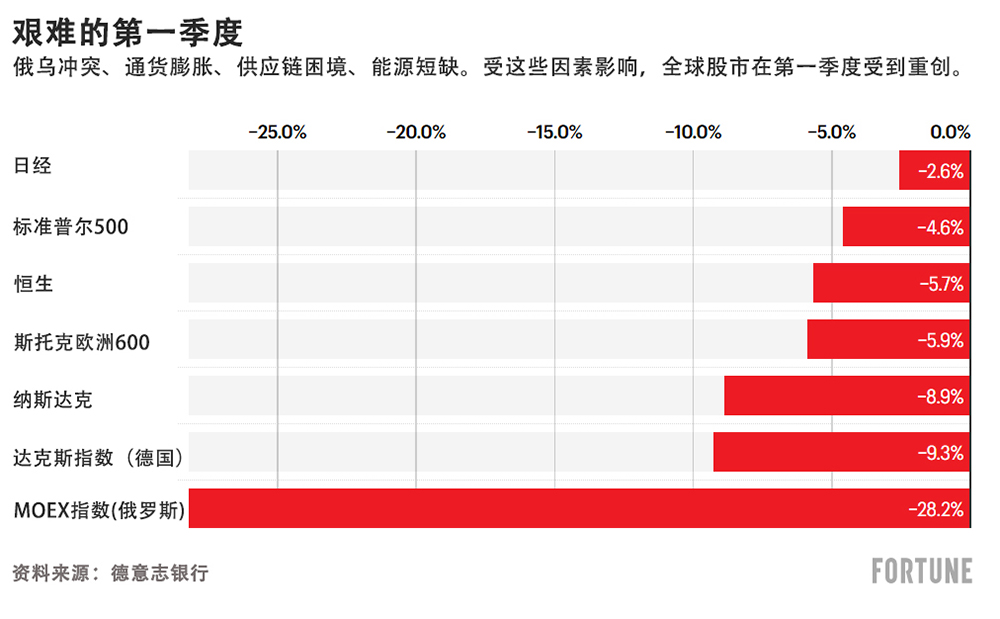从主权债券到加密货币再到科技股,刚刚结束的这个季度对投资者来说都很艰难。
事实上,根据德意志银行的数据,这是自2020年第一季度(新冠肺炎疫情封锁季度,投资收益惨淡)以来股票和固定收益资产表现最糟糕的一个季度。不过,这一次,不仅仅是因为新冠肺炎疫情,而且还因为在此期间一众金融骗子压低风险资产。
德意志银行主题研究团队的吉姆·里德(Jim Reid)和亨利·艾伦(Henry Allen)在周五的投资者综述中写道:“第一季度的金融市场经历了戏剧性时期,这一时期,俄乌冲突爆发,通货膨胀加速,美联储开始新一轮加息周期,此外,2年期和10年期美国国债收益率曲线倒挂。这种动荡意味着我们样本中的大多数资产在本季度都出现了下跌,38种非货币资产中只有9种处于正值区域。”
所谓实现盈利的九种资产包括大宗商品和万能的美元。布伦特原油在本季度飙升38%,推高了各地的通货膨胀率,并给世界上最大的央行施加了加息压力。与此同时,美元指数上涨2.8%,这是美元连续第三个季度的上涨。强势美元通常会严重削弱美国跨国公司盈利。

如图所示,科技股在上个季度受到重创。由于美联储开始提高利率以抑制通胀,纳斯达克指数下跌8.9%。情况本来会更糟,但科技股指数在3月份实际上涨了3.5%。俄罗斯的主要交易所MOEX情况最糟糕。尽管MOEX在3月的大部分时间都处于关闭状态,但它还是下跌了28.2%。
标准普尔500指数情况最差,该指数在美国资产中表现最好或者说是“差中最优”,总回报率为-4.6%。
该图表没有显示主权债券的糟糕状况。10年期美国国债在本季度下跌5.5%,吉姆·里德和亨利·艾伦写道:“这是自1999年以来最糟糕的季度表现。”与此同时,德国国债下跌5.1%。债券暴跌表明投资者对未来几年的经济增长越来越担心。
该图表也没有显示比特币的状况。加密货币之王比特币2022年开盘时的交易价格为47,300美元。今天早上它的交易价格为45,100美元,年初至今下跌了2.7%。(财富中文网)
译者:ZHY
从主权债券到加密货币再到科技股,刚刚结束的这个季度对投资者来说都很艰难。
事实上,根据德意志银行的数据,这是自2020年第一季度(新冠肺炎疫情封锁季度,投资收益惨淡)以来股票和固定收益资产表现最糟糕的一个季度。不过,这一次,不仅仅是因为新冠肺炎疫情,而且还因为在此期间一众金融骗子压低风险资产。
德意志银行主题研究团队的吉姆·里德(Jim Reid)和亨利·艾伦(Henry Allen)在周五的投资者综述中写道:“第一季度的金融市场经历了戏剧性时期,这一时期,俄乌冲突爆发,通货膨胀加速,美联储开始新一轮加息周期,此外,2年期和10年期美国国债收益率曲线倒挂。这种动荡意味着我们样本中的大多数资产在本季度都出现了下跌,38种非货币资产中只有9种处于正值区域。”
所谓实现盈利的九种资产包括大宗商品和万能的美元。布伦特原油在本季度飙升38%,推高了各地的通货膨胀率,并给世界上最大的央行施加了加息压力。与此同时,美元指数上涨2.8%,这是美元连续第三个季度的上涨。强势美元通常会严重削弱美国跨国公司盈利。
科技股在上个季度受到重创。由于美联储开始提高利率以抑制通胀,纳斯达克指数下跌8.9%。情况本来会更糟,但科技股指数在3月份实际上涨了3.5%。俄罗斯的主要交易所MOEX情况最糟糕。尽管MOEX在3月的大部分时间都处于关闭状态,但它还是下跌了28.2%。
标准普尔500指数情况最差,该指数在美国资产中表现最好或者说是“差中最优”,总回报率为-4.6%。
该图表没有显示主权债券的糟糕状况。10年期美国国债在本季度下跌5.5%,吉姆·里德和亨利·艾伦写道:“这是自1999年以来最糟糕的季度表现。”与此同时,德国国债下跌5.1%。债券暴跌表明投资者对未来几年的经济增长越来越担心。
该图表也没有显示比特币的状况。加密货币之王比特币2022年开盘时的交易价格为47,300美元。今天早上它的交易价格为45,100美元,年初至今下跌了2.7%。(财富中文网)
译者:ZHY
From sovereign bonds to crypto to tech stocks, the quarter that just ended was a rough one for investors.
In fact, it was the worst quarter for stocks and fixed-income assets since Q1 2020, the infamous COVID lockdown quarter, according to Deutsche Bank. This time, though, it wasn't just COVID, but a rogues' gallery of miscreants pushing down risk assets in the period.
"Q1 was a dramatic time in financial markets, featuring Russia’s invasion of Ukraine, accelerating inflation, the start of another hiking cycle from the Federal Reserve, as well as an inversion of the 2s10s yield curve. That turbulence meant that the majority of assets in our sample have lost ground over the quarter, with just nine of the 38 non-currency assets in positive territory," writes Jim Reid and Henry Allen of Deutsche Bank's thematic research team, in an investor roundup note on Friday.
The so-called winning nine included commodities and the almighty dollar. Brent crude soared 38% in the quarter, pushing up inflation everywhere and putting pressure on the world's biggest central banks to begin raising interest rates. The dollar was up 2.8%, meanwhile, its third straight quarter of gains. A strong dollar typically hits the bottom line of U.S. multinationals hard.
As the chart shows, tech bulls got clobbered last quarter. The Nasdaq fell 8.9% as the Federal Reserve began raising interest rates to put the brakes on inflation. It could have been worse. The tech-heavy index actually climbed 3.5% in March. The worst of the bunch? Russia's principal exchange, the MOEX. It fell 28.2% even though it was shut down for most of March.
The booby prize goes to the S&P 500, which turned in the best—or "least worst"—performance for U.S. assets, with a total return of -4.6%.
Not pictured in the chart is the rotten performance of sovereign bonds. Ten-year U.S. Treasuries notes fell 5.5% in the quarter, "their worst quarterly performance since it begins in 1999," Reid and Allen write. German bunds, meanwhile, fell 5.1%. The rout in bonds shows investors are growing increasingly wary about economic growth in the years ahead.
Also not pictured in the chart is Bitcoin. The king of crypto opened 2022 trading at $47,300. This morning it was trading at $45,100, a year-to-date decline of 2.7%.






